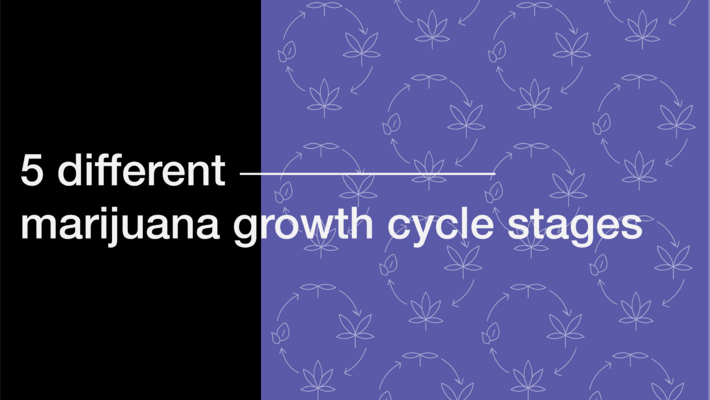
5 Different Marijuana Growth Cycle Stages
Published on 7/5/20
After countless trips to the dispensary and hundreds of dollars spent, you might find yourself wondering - how does weed grow? The process of growing cannabis from tiny and fragile marijuana seedlings to bushy trees filled with glistening buds is incredibly gratifying. Growers are rewarded with a sense of accomplishment and the knowledge that they can take something minute and nurture it into a large and fully-grown plant. And, as we all know, if the process is managed correctly, growers are also rewarded with lovely sticky buds to enjoy.
The key to growing cannabis for personal use is to provide an environment that ensures the correct amount of lighting, humidity, food, air circulation and pest control. An awareness of the stages your plant (or plants) will go through is critical to developing an understanding of how best to guide your weed through the cannabis life cycle.
How Long Does It Take to Grow Weed?

The marijuana growth cycle can be as quick as eight weeks and as long as six months. The factors that dictate the wide range of time involved in the marijuana life cycle include the type of strain, the growing method and the amount of yield the grower desires. Strains that can make the jump quickly from seed to mature buds tend to be indicas like OG Kush, Northern Lights and White Widow. It's no secret why growers love working with strains like these since they mature rapidly and they provide excellent effects. Sativa-leaning strains like Sour Diesel, Durban Poison and other "hazes" such as Amnesia Haze, reside on the other end of the spectrum and will take a bit longer to fully mature.
The more you know about the stages of growing weed, the better prepared you will be to guide your plant or plants to a successful harvest. Let's take a look at the cannabis growth stages so you know what to expect as you watch your seeds or clones turn into majestic plants loaded with juicy buds.
Germination Stage
Just like its brothers and sisters across the plant kingdom, the marijuana plant begins with a seed. Healthy and mature seeds should be hard, shiny, brown and dry. The seed contains a living plant, but it will remain in stasis until it is exposed to water, light and warmth. Hormones within the seeds are then activated and the initial growth stage begins. A single root will break through the hard shell, or husk, of the seed and push downwards as a stem followed by more shoots before sprouting two cotyledon leaves. The leaves are called meristems and they consist of cells that have the ability to divide and create new cells. Once the meristems are visible the plant will begin to grow. If a seed does not enter conditions that induce germination it will eventually decay and die. Depending on the seed and the strain, the germination stage can take between one day to one week to complete.
Sprouting Stage

In this brief stage, moisture envelops the seed and it begins to sprout. It has reached the point where the shell is no longer necessary and it is ready to exist on its own. The shell is jettisoned and the marijuana seedling will begin its diet of water, air and heat.
Seedling Stage
The seedling stage is one of the most delicate stages of marijuana growth. Heat and humidity levels should be monitored carefully to allow the seedling to develop properly and avoid pests and mold. It is important to not overwater or over fertilize during this stage. It is also the time when light is most needed to encourage root and leaf growth. The seedling stage is one of the more exciting marijuana growth stages because as the root systems develop, leaves also begin to take shape and grow and the iconic seven-point marijuana leaf makes its first appearance. The entire stage will take between two to four weeks.
Vegetative Stage

Things start getting really fun in this period of the marijuana life cycle. The foliage begins to kick in and the marijuana plant surges in size. It is not uncommon for it to experience growth of a few inches in one day. The plant is now able to absorb more food and it is critical to supply it with the proper sustenance. It will love potassium and phosphorus-based nutrients, as well as nitrogen, which is a big player at this stage because it assists with the development of chlorophyll. An increase in light and water is also of great importance as the marijuana plant expands. The length of the vegetative stage can vary greatly depending on the strain, but it usually lasts a bit less than one month.
Flowering Stage

The end of the marijuana life cycle is known as the flowering stage and it is a fitting conclusion to a fascinating journey through the various cannabis plant stages. Once this phase is complete the marijuana plant will be ready for harvest. The biggest change from a growing perspective is the need to reduce the amount of light that the plant receives. Buds begin to evolve and sticky resin will appear on the outside of the leaves. Cannabis flowering stages last between six to 10 weeks but occasionally extend to as much as 12 weeks. It is crucial to allow the stage to finish completely before reaping the rewards. The time is right when the majority of the hairs on the buds (known as pistils) turn brown and the larger leaves on the marijuana plant exhibit soft shades of yellow.
Are you an avid cannabis grower? Have you tried to grow your own weed? Leave a note in the comment section about your experience enjoying each unique moment of the different marijuana growth stages.
